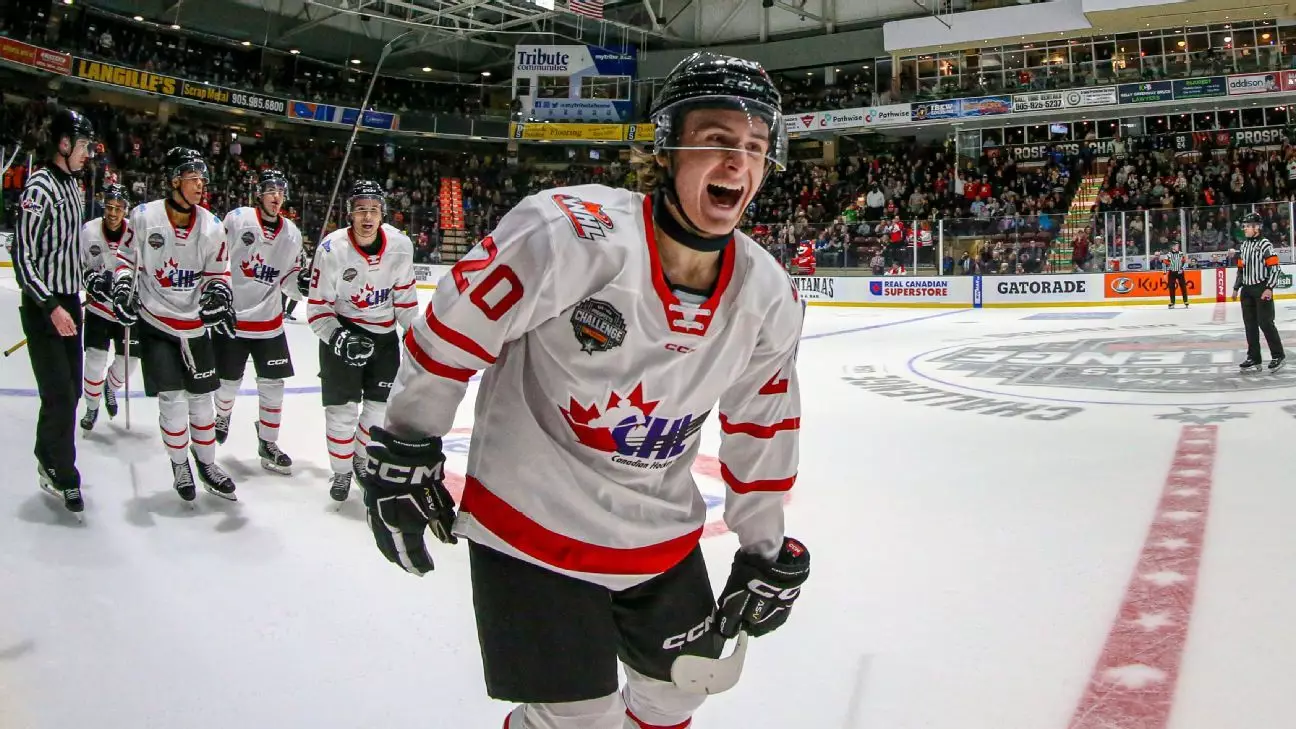The recent CHL-USA Prospects Challenge held in London and Oshawa, Ontario, provided fans and scouts alike with an exhilarating glimpse of young hockey talent. It was a showcase not only for emerging players vying for a spot in the NHL but also a significant event on the scouting calendar ahead of the upcoming drafts. Team CHL’s dominance in both games, winning 6-1 and narrowly securing a 3-2 victory, highlighted their depth and skill level, especially among players projected to be top contenders in the next NHL draft.
This event was particularly intriguing because it offered insights into a supposed down year for CHL talent, a narrative quickly dispelled by the performances witnessed. With discussions around draft prospects often dominated by individual player narratives, the challenge illuminated how team dynamics and individual attributes can evolve when emerging talents face off against their U.S. counterparts.
Among the standout players, Matthew Schaefer stole the spotlight with his impressive two-way game. The left-handed defenseman didn’t just meet expectations—he exceeded them dramatically, stunning scouts and fans alike with his versatility and ability to dictate the game’s flow. His performance, especially in Game 1, showcased a blend of speed, puck management, and an astute understanding of both offensive and defensive responsibilities. Notably, his end-to-end rushes were a festival of skill, marking him as a player who not only breaks the mold but potentially sets a new standard for defensemen in his draft class.
Interestingly, Scouts noted that if Schaefer were a right-handed shot, he could be a front-runner for the first overall pick. His drafting potential, therefore, not only hinges on his skills but also on positional value within the NHL—an aspect that makes his performance even more compelling for teams looking to bolster their blue line.
Working in concert with Schaefer was the CHL’s formidable top line comprising Porter Martone, Michael Misa, and Caleb Desnoyers. This trio proved to be a continuous offensive threat throughout the two games, constantly challenging the American defense. Martone and Misa’s chemistry was particularly notable, as they demonstrated an uncanny ability to manipulate the pace of the game and create scoring opportunities seemingly at will. Their offensive prowess was complemented by Desnoyers, who not only contributed offensively but also excelled in a supportive role, showcasing remarkable hockey IQ and awareness on the ice.
Desnoyers’ adaptability and commitment to both ends of the ice truly shone during Game 2, highlighting his capacity to be an all-around player. His ability to capitalize on opportunities created by his linemates while also shutting down opposing players underscores the intelligence required at higher levels of play, making him a player to watch closely moving forward.
On the other side, the USA team, despite the loss, had notable performances, particularly from Jack Murtagh and goalie Harrison Boettiger. Murtagh, as arguably the most effective American forward, demonstrated his knack for generating offensive chances, coupled with a remarkable ability to find soft spots in the defense. His overall contribution may not have resulted in an overwhelming number of scoring opportunities, but it served as an example of determination and skill that could play a pivotal role in his draft aspirations.
Boettiger, meanwhile, provided a beacon of hope in an otherwise challenging competitive landscape for the USA. His play in goal, especially in Game 2, was characterized by athleticism and quick reflexes that prevented what could have easily turned into a comprehensive defeat. The young goaltender’s resilience, particularly after a shaky first 30 seconds, was indicative of not just talent but mental fortitude—an invaluable trait in a goaltender at any level.
The impact of this event ripples throughout the upcoming NHL draft discussions. Although sparking debates and heightened analysis among scouts and general managers alike, it is crucial to recognize that these performances, although significant, are but two games in a long season of evaluations. Each game offers a snapshot rather than a full portrait, but it showcases the random moments that can influence draft rankings.
With teams looking to solidify their futures, standout performances from Schaefer, Martone, Misa, and others will likely tip the scales as draft boards are finalized. The insights gained from the CHL-USA Challenge not only highlight the skillsets of individuals but also serve as a reminder of the importance of competition and situational play in determining a player’s readiness for the NHL. As preparations shift toward the under-18 World Championships, one thing is for certain: this event may have reshaped perceptions and provided fresh narratives as the hockey community turns its attention to the draft season ahead.


Leave a Reply